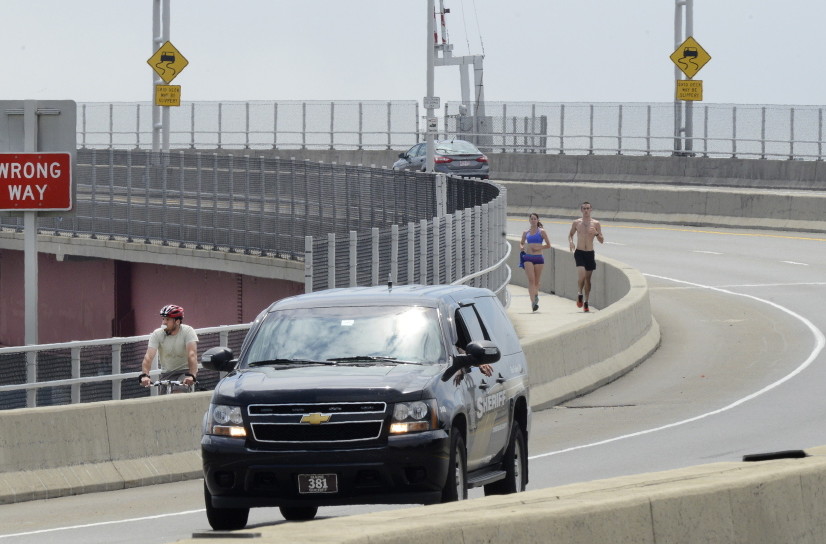Pedestrians and bicyclists traveling over the busy Casco Bay Bridge linking Portland and South Portland will be forced to use the unprotected shoulder over the next few weeks while the sidewalk is temporarily closed for repairs.
The Maine Department of Transportation is asking pedestrians to make alternative plans while the MDOT repairs the protected sidewalk on the drawbridge. Construction is scheduled to begin Monday and finish Aug. 10, with the sidewalk reopening the next day.
“It’s a tough project that needs to be done,” said Tim Soucie, a regional traffic engineer with the MDOT. “It’s our hope that pedestrians find alternative means of transportation during this time.”
Some pedestrian and bicycling advocacy groups said Tuesday that the MDOT ought to take steps during construction, such as erecting a barrier along the shoulder, to protect pedestrians and bicyclists.
Soucie said the 250-foot section of the sidewalk on the lift span will be sandblasted, primed and painted – a job that can only be done in warm weather when the paint can cure properly.
“It’s important that this work get done,” Soucie said. “It will lengthen the life of the structure so we don’t have to do an extensive project down the road.”
A large neon sign warning pedestrians and drivers of the closure stood at the Portland entrance to the bridge Tuesday. The MDOT has also placed signs at the entrances to the sidewalk suggesting people take the bus or some other transportation across the bridge.
Jake Boston, a South Portland resident who works at a call center on Commercial Street, walks to and from work across the bridge each day. He said he can take the bus to work, but the buses have stopped running by the time he gets out at 1 a.m., and taxis are too expensive.
“I’m probably going to be carefully walking on the pavement when I’m going home at night,” said Boston, 26, while walking over the bridge Tuesday afternoon. “But that’s a bridge I’ll have to cross when I get there.”
During the afternoon commute on Thursday, May 15, from 4 to 6 p.m., 54 bikes and 37 pedestrians crossed the bridge, according to a count conducted by the Portland Area Comprehensive Transportation System.
The system, a federally funded metropolitan planning organization that serves the Portland area, twice a year counts the number of pedestrians who use the bridge from the ramp at Thomas Knight Park in South Portland. Paul Niehoff, senior transportation planner, said the system also does counts of weekend travelers, and found that 10 bikes and six pedestrians crossed the bridge from 12 to 2 p.m. on Saturday, May 10.
“There is a concern from a number of people about what’s going to happen during construction,” Niehoff said.
Portland-area advocacy groups, including the Bicycle Coalition of Maine, are looking for ways to keep walkers and bicyclists informed and safe during construction.
“(Riding the bus) is probably the safest way to cross the bridge,” said Brian Allenby, communications director for the Bicycle Coalition of Maine. “But there may be folks who want to walk or cannot afford alternative transportation.”
Allenby suggested putting up a temporary barrier along the bike lane, such as an orange jersey barrier or even traffic cones.
“If maintenance needs to be made, it needs to be made,” Allenby said. “We hope to find a way for everyone to come across the bridge safely.”
Portland Trails, a nonprofit urban land trust and trail-building organization, also wants to work with the MDOT on an alternative to having pedestrians use the bike lane along the shoulder during construction, said Jaime Parker, a trails manager with the group.
“The heavily used path is part of a network that a lot of pedestrians use,” Parker said. Some physical separation between the cars and pedestrians during construction would be a safer option, he said.
But Soucie said the MDOT has no plans to put up a temporary barrier.
The bike lane is marked by a solid white line but there is no barrier that separates the lane from motor vehicles on the bridge, where the posted speed limit is 40 mph.
According to Soucie, there have been 53 accidents on the bridge in the past three years, only one of which involved a bicycle. The majority of accidents, Soucie said, were minor rear-end collisions.
About 13,650 vehicles a day pass through the intersection of High and Spring streets, at the Portland side of the bridge entrance, according to a 2013 article in the Press Herald.
Barbie Lutz, a 55-year-old South Portland resident who walks to work in Portland every day, said she isn’t worried about the sidewalk closure.
“I’ll still walk and just be careful using the road,” she said.
Send questions/comments to the editors.



Success. Please wait for the page to reload. If the page does not reload within 5 seconds, please refresh the page.
Enter your email and password to access comments.
Hi, to comment on stories you must . This profile is in addition to your subscription and website login.
Already have a commenting profile? .
Invalid username/password.
Please check your email to confirm and complete your registration.
Only subscribers are eligible to post comments. Please subscribe or login first for digital access. Here’s why.
Use the form below to reset your password. When you've submitted your account email, we will send an email with a reset code.